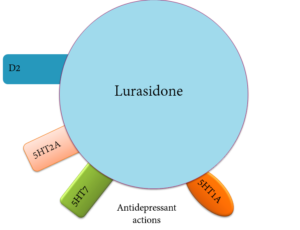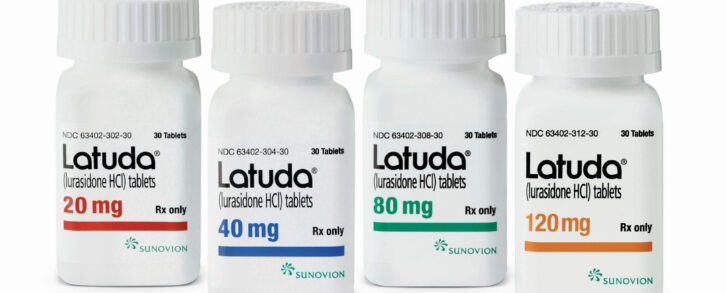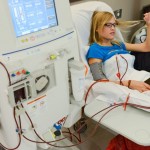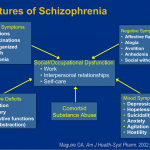11
Jul
2018
Lurasidone : Latuda
Posted On July 11, 2018
By Dr.Adel Serag
And has No Comment
What’s of Interest:
- Latuda is now approved for pediatric bipolar depression (ages 10 and older)
Brands
- Latuda
Class
- Atypical antipsychotic (serotonin-dopamine antagonist; second generation antipsychotic; also a mood stabilizer)

Approved For:
- Schizophrenia (ages 13 and older)
- Bipolar depression (ages 10 and older, monotherapy)
- Bipolar depression (adults, adjunct)
Formulation:
- Tablet 20 mg, 40 mg, 60 mg, 80 mg, 120 mg
How To Dose in Children and Adolescents:
- Schizophrenia: initial 40 mg once daily with food; maximum recommended dose 80 mg/day; often a good idea to initiate at 20 mg to test for tolerability before raising the dose to 40 mg, especially in children and in small body weight adolescents
- Bipolar depression: initial 20 mg once daily with food; can increase after 1 week; maximum recommended dose of 80 mg/day
Dosing Tips:

- Lurasidone should be taken with food (i.e., at least a small meal of a minimum of 350 calories)
- In children and adolescents, use lower starting dose for those without prior exposure to antipsychotics, especially if not switching from another antipsychotic
- In patients who have no prior exposure to antipsychotics, there may be more nausea than in those who have been exposed
- Studies in adults show side effects are less frequent when given at night than when given during the day
- Some children benefit from twice daily dosing mostly to improve tolerability
Weight Gain:
- Weight gain was not apparent in short-term adolescent studies
- In adult studies, many experienced about one- to two-pound weight gain greater than placebo in short-term 6-week trials; patients in long-term 52-week trials actually lost 1.5 pounds on average
- However, children and adolescents may be more susceptible to side effects
Sedation:
- Many patients experience and/or can be significant in amount
- May be higher in short-term trials than in long-term use
Other Notable or Dangerous Side Effects:
- Dose-dependent sedation, dizziness
- Akathisia, EPS (EPS, also called drug-induced parkinsonism)
- Nausea, vomiting
- Dose-dependent hyperprolactinemia
- May increase risk for diabetes and dyslipidemia
- Rare tardive dyskinesia (risk may be higher in children than it is in adults)
- Tachycardia, first-degree AV block
- Hyperglycemia, in some cases extreme and associated with ketoacidosis or hyperosmolar coma or death, has been reported in patients taking atypical antipsychotics
- Rare neuroleptic malignant syndrome (much reduced risk compared to conventional antipsychotics)
- Rare seizures
Warnings:
- Use with caution in patients with conditions that predispose to hypotension (dehydration, overheating)
- Dysphagia has been associated with antipsychotic use, and lurasidone should be used cautiously in patients at risk for aspiration pneumonia
- As with any antipsychotic, use with caution in patients with history of seizures
- Carefully weigh the risks and bene?ts of pharmacological treatment against the risks and bene?ts of nontreatment with an antipsychotic; it is a good idea to document this in the patient’s chart
- In children and adolescents, consider distributing brochures provided by the FDA and the drug companies
- When lurasidone is used to treat depressive episodes in children, it is a good idea to warn patients and their caregivers about the possibility of activating side effects and suicidality (as for any antidepressant in this age group) and advise them to report such symptoms immediately
Contraindications:
- If patient is taking a strong CYP 3A4 inhibitor (e.g., ketoconazole) or inducer (e.g., rifampin)
- In patients with a history of angioedema
- If there is a proven allergy to lurasidone
Pharmacokinetics:
- Half-life in adults is 18–31 hours (shorter half-life better documented at the 40 mg dose)
- In pediatric clinical trials (ages 10 to 17), the exposure of lurasidone was similar to that in adults, without adjusting for body weight
- Metabolized by CYP450 3A4
- Cmax and bioavailability are reduced if taken without food
Drug Interactions:
- Inhibitors of CYP450 3A4 (e.g., nefazodone, fluvoxamine, fluoxetine, ketoconazole) may increase plasma levels of lurasidone
- Coadministration of lurasidone with a strong CYP450 3A4 inhibitor (e.g., ketoconazole) or with a strong CYP450 3A4 inducer (e.g., rifampin) is contraindicated
- Coadministration of lurasidone with moderate CYP450 3A4 inhibitors can be considered; recommended starting dose is 20 mg/day; recommended maximum dose is 80 mg/day
- Moderate inducers of CYP450 3A4 may decrease plasma levels of lurasidone
- May increase effect of antihypertensive agents
- May antagonize levodopa, dopamine agonists
Pregnancy:
- Effective June 30, 2015, the US FDA requires changes to the content and format of pregnancy and lactation information in prescription drug labels, including the elimination of the pregnancy letter categories; the Pregnancy and Lactation Labeling Rule (PLLR or final rule) applies only to prescription drugs and will be phased in gradually for drugs approved on or after June 30, 2001
- Controlled studies have not been conducted in pregnant women
- Animal studies do not show adverse effects
- There is a risk of abnormal muscle movements and withdrawal symptoms in newborns whose mothers took an antipsychotic during the third trimester; symptoms may include agitation, abnormally increased or decreased muscle tone, tremor, sleepiness, severe difficulty breathing, and difficulty feeding
- Not teratogenic in rodents
- Psychotic symptoms may worsen during pregnancy and some form of treatment may be necessary
- National Pregnancy Registry for Atypical Antipsychotics: 1-866-961-2388 or http://womensmentalhealth.org/clinical-and-research-programs/pregnancyregistry
Renal Impairment:
- In adults, moderate and severe impairment: initial 20 mg/day; maximum dose 80 mg/day
- Possibly reduce these doses by half in children and adolescents
Hepatic Impairment:
- In adults, moderate impairment: initial 20 mg/day; maximum dose 80 mg/day
- In adults, severe impairment: initial 20 mg/day; maximum dose 40 mg/day
- Possibly reduce these doses by half in children and adolescents
Cardiac Impairment:
- Should be used with caution because of theoretical risk of orthostatic hypotension, although low potency at alpha 1 receptors suggests this risk may be less than for some other antipsychotics
- Lurasidone is one of the few antipsychtoics that does not have a warning for QTc prolongation







